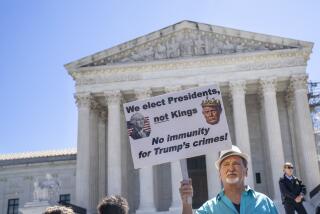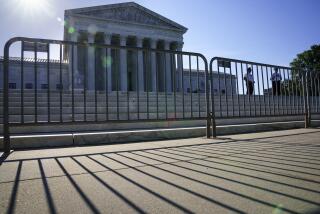1776 to 2008
- Share via
The Declaration of Independence, which we honor today, is replete with the internal tensions and contradictions of 18th century America, a paean to equality written by a slaveholder, a proclamation of “unalienable rights” by white, landed men willing to bestow those rights only on a precious few. If many of the contradictions of the declaration and its more sober counterpart, the Constitution, have been resolved over time -- some by war, others by protest -- one abiding point of stress continues to vex the modern nation: Is ours a country of order, of institutions and constitutional provisions, or one of revolutionary upheaval, suspicious of power and the authorities who wield it? The answer, of course, is that it is both, though we often forget it.
In the eyes of the declaration’s signers, government existed only to secure God-given rights, namely life, liberty and the pursuit of happiness. Angered by their treatment at the hands of the British crown, those revolutionary patriots declared that their king had failed them -- had, they wrote, subjected them to “a history of repeated injuries and usurpations.” They thus announced the right to break away. “Whenever any form of government becomes destructive of these ends,” they wrote, “it is the right of the people to alter or to abolish it, and to institute new government. “
Once their victory was won and it came time to form a government, the drafters of the Constitution resolved to construct a state that could evolve over time, one built on essential principles rather than explicit dictates. The revolutionary fervor of the declaration found accommodation in the Constitution, where those passions were harnessed but not extinguished.
The great biographies of the founding fathers published in recent years frame the tension between revolutionary liberty and social order in personal as well as philosophical terms. George Washington and especially Alexander Hamilton stood for order -- a central bank, a powerful president. Thomas Jefferson and James Madison defended liberty, even at the expense of order. “The tree of liberty,” Jefferson memorably wrote to a friend, “must be refreshed from time to time with the blood of patriots and tyrants.”
Those opposing impulses have tested American society again and again. It has responded in ways sometimes thrilling and sometimes tragic. Confronted with challenges to political order in the early republic, President John Adams signed the Alien and Sedition Acts and ushered in a period of bitter recrimination. Terrified by the prospect of an attack on the mainland after Pearl Harbor, President Franklin D. Roosevelt approved the internment of more than 100,000 Japanese and Japanese Americans charged with no crime. Faced with rising cries for racial equality through the middle of the 20th century, many Americans resisted but eventually -- led by their courts -- yielded to the dismantling of American apartheid, first in schools, then in all manner of public institutions and finally, in 1967, in marriage.
Those stresses are no less fundamental today as we contemplate national security in a war without limits; as we consider personal privacy and a prying government; as we debate the right to own a gun and government’s place in regulating that right; as we argue over immigration, legal and illegal; as we consider the definition of marriage; as we question the state’s right to put its citizens to death.
None of these issues is best addressed by absolutists. No sensible person would trade all rights of speech and protest in order to fight Al Qaeda; if they were to succeed, there would be nothing left to fight for. Even the most ardent privacy advocate would concede the government’s right, under some circumstances, to forcibly enter a private home -- to seize drugs, say, or to arrest a child molester. Few are willing to open our borders entirely. Only the daft see same-sex marriage as a step toward polygamy.
If we are to harmonize our historic embrace of liberty with our respect for order, what must guide us, then, is an appreciation for institutions and a regard for progress, particularly as it opens those institutions to those who have been excluded. Immigrants, whether illegal or legal, come to this country to work and raise families; they must not be demonized but rather embraced. Those who would expel all these families offend our sense of liberty and our belief in this as a land of refuge and opportunity; those who would open the border altogether disrupt our right to an orderly and lawful society. The resolution lies, as it so often does, in the center: Immigrants who arrived illegally but who work and obey the laws once here deserve the right to stay. And the border still warrants protection.
Similarly, lesbians and gays ask not for the abolition of marriage but rather, like those interracial couples of years past, to be part of an institution that shapes so many of our lives and social structures. Those who would deny that right blaspheme our history of freedom. Thankfully, gay and lesbian couples who yearn to formalize their love with marriage received the beneficence of a just court, as interracial couples did two generations ago.
Because they are the venue where individuals go to assert their rights, our courts have long struggled with how best to allow American society to evolve under the strictures of the Constitution, how to re-imagine ourselves in modern times without departing from the principles that make us a nation. Chief Justice Earl Warren presented one provocative idea in the context of our views about crime and punishment, specifically the 8th Amendment’s protection against “cruel and unusual” punishment. “The words of the amendment are not precise,” Warren wrote for the court in 1958, “and ... their scope is not static. The amendment must draw its meaning from the evolving standards of decency that mark the progress of a maturing society.”
That analysis, cited last week by the Supreme Court in ruling that the death penalty may not be applied to defendants who did not kill their victims, is much derided by defenders of a rigid order. To them, it allows too much leeway for judges to consider and apply those “evolving standards.” But the alternative is no less offensive: Must we accept the stock and the pillory, the whip and the brand, merely because our forefathers did not consider them cruel? Regard for history and appreciation of change, not demagoguery or stasis, should supply the answer.
One of the Supreme Court’s great conservatives, Justice John Marshall Harlan, sketched out much of his jurisprudence in dissent as he served at the height of the Warren court years. He, as much as any of the brethren, worked assiduously to balance the impulses of liberty and order. He did so by exploring and developing the concept of “ordered liberty.”
To Harlan, ordered liberty provided a means of selectively extending our most fundamental rights, those that gave shape to our system of justice -- the rights of speech and association, the right to a jury trial and to be represented by a lawyer and the like. But if it had particular meaning in the debate about which rights state governments were required to protect, it also served to emphasize our love of liberty and our need for order. In Harlan’s writing, the police may serve warrants but must respect the privacy of one’s home. Conservatives who fret about giving privacy constitutional standing -- mainly because it supports the right to an abortion -- should pause over Harlan’s analysis. “The concept of ‘privacy’ embodied in the 4th Amendment,” he wrote years before Roe vs. Wade, “is part of the ‘ordered liberty’ assured against state action.”
Those are the words not of a “judicial activist” but rather of a restrained and careful jurist, a modest and brilliant proponent of a cautious judiciary but not a cowardly one, a man committed to balance.
“The balance of which I speak is the balance struck by this country, having regard to what history teaches are the traditions from which it developed as well as the traditions from which it broke,” Harlan wrote in 1961. “That tradition is a living thing. A decision of this court which radically departs from it could not long survive, while a decision which builds on what has survived is likely to be sound. No formula could serve as a substitute, in this area, for judgment and restraint.”
We may never resolve the tension between liberty and order, between freedom and security, between history and progress, that found such exquisite expression in the revolutionary document signed 232 years ago today. But Harlan’s belief in “judgment and restraint,” along, perhaps, with a dash of full-hearted humanity, is as sound as ever, and a guide to us all.
--
(BEGIN TEXT OF INFOBOX)
Human events
The authors of the Declaration of Independence used it to proclaim the Colonies’ freedom from British rule, of course, but also to enumerate their many grievances. Two centuries later, the document retains a surprisingly contemporary vitality, its list of “usurpations” resonating today in its condemnation of trials without juries, transporting men “beyond seas to be tried for pretended offenses” and obstructing immigration, among other offenses, large and small. For a look at the declaration in modern life, visit latimes.com/declaration.
And “let facts be submitted to a candid world.”
More to Read
Sign up for Essential California
The most important California stories and recommendations in your inbox every morning.
You may occasionally receive promotional content from the Los Angeles Times.










